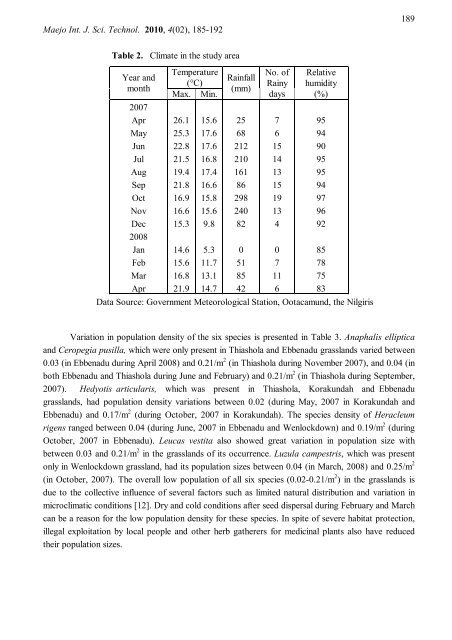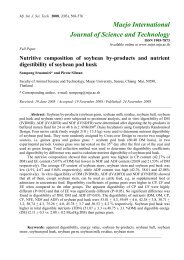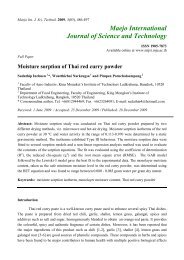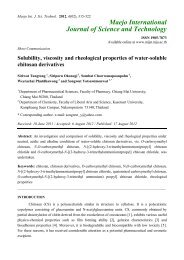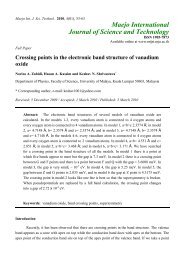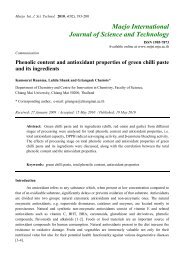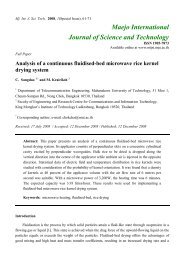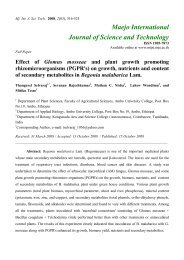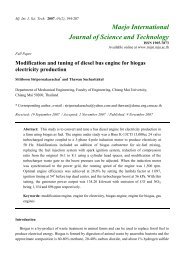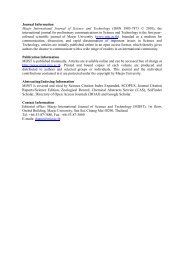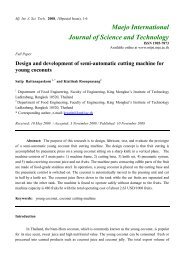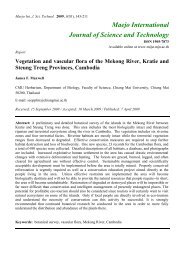Phenological observation and population dynamics of six ...
Phenological observation and population dynamics of six ...
Phenological observation and population dynamics of six ...
You also want an ePaper? Increase the reach of your titles
YUMPU automatically turns print PDFs into web optimized ePapers that Google loves.
Maejo Int. J. Sci. Technol. 2010, 4(02), 185-192189Table 2. Climate in the study areaYear <strong>and</strong>month2007AprMayJunJulAugSepOctNovDec2008JanFebMarAprTemperature(°C)Max. Min.26.125.322.821.519.421.816.916.615.314.615.616.821.915.617.617.616.817.416.615.815.69.85.311.713.114.7Rainfall(mm)256821221016186298240820518542No. <strong>of</strong>Rainydays76151413151913407116Relativehumidity(%)Data Source: Government Meteorological Station, Ootacamund, the Nilgiris95949095959497969285787583Variation in <strong>population</strong> density <strong>of</strong> the <strong>six</strong> species is presented in Table 3. Anaphalis elliptica<strong>and</strong> Ceropegia pusilla, which were only present in Thiashola <strong>and</strong> Ebbenadu grassl<strong>and</strong>s varied between0.03 (in Ebbenadu during April 2008) <strong>and</strong> 0.21/m 2 (in Thiashola during November 2007), <strong>and</strong> 0.04 (inboth Ebbenadu <strong>and</strong> Thiashola during June <strong>and</strong> February) <strong>and</strong> 0.21/m 2 (in Thiashola during September,2007). Hedyotis articularis, which was present in Thiashola, Korakundah <strong>and</strong> Ebbenadugrassl<strong>and</strong>s, had <strong>population</strong> density variations between 0.02 (during May, 2007 in Korakundah <strong>and</strong>Ebbenadu) <strong>and</strong> 0.17/m 2 (during October, 2007 in Korakundah). The species density <strong>of</strong> Heracleumrigens ranged between 0.04 (during June, 2007 in Ebbenadu <strong>and</strong> Wenlockdown) <strong>and</strong> 0.19/m 2 (duringOctober, 2007 in Ebbenadu). Leucas vestita also showed great variation in <strong>population</strong> size withbetween 0.03 <strong>and</strong> 0.21/m 2 in the grassl<strong>and</strong>s <strong>of</strong> its occurrence. Luzula campestris, which was presentonly in Wenlockdown grassl<strong>and</strong>, had its <strong>population</strong> sizes between 0.04 (in March, 2008) <strong>and</strong> 0.25/m 2(in October, 2007). The overall low <strong>population</strong> <strong>of</strong> all <strong>six</strong> species (0.02-0.21/m 2 ) in the grassl<strong>and</strong>s isdue to the collective influence <strong>of</strong> several factors such as limited natural distribution <strong>and</strong> variation inmicroclimatic conditions [12]. Dry <strong>and</strong> cold conditions after seed dispersal during February <strong>and</strong> Marchcan be a reason for the low <strong>population</strong> density for these species. In spite <strong>of</strong> severe habitat protection,illegal exploitation by local people <strong>and</strong> other herb gatherers for medicinal plants also have reducedtheir <strong>population</strong> sizes.


